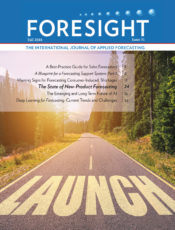 This Fall 2018 issue of Foresight, our 51st, opens with Fotios Petropoulos’s review of Paul Goodwin’s latest book, How to Profit from Your Software: A Best-Practice Guide for Sales Forecasters. Fotios notes that the author doesn’t single out any one software system, but keeps the discussion general and so applicable to many products. He lauds the book’s accessibility, concluding that “Paul Goodwin has delivered a smoothly written and often surprisingly nontechnical introduction to forecasting methods. It constitutes a reference of best practices that will enable users to derive the most out of their forecasting software.” High praise indeed.
This Fall 2018 issue of Foresight, our 51st, opens with Fotios Petropoulos’s review of Paul Goodwin’s latest book, How to Profit from Your Software: A Best-Practice Guide for Sales Forecasters. Fotios notes that the author doesn’t single out any one software system, but keeps the discussion general and so applicable to many products. He lauds the book’s accessibility, concluding that “Paul Goodwin has delivered a smoothly written and often surprisingly nontechnical introduction to forecasting methods. It constitutes a reference of best practices that will enable users to derive the most out of their forecasting software.” High praise indeed.
The previous issue, our landmark number 50 (Summer 2018), included Part 1 of an article by Matthias Lütke Entrup and Dennis Goetjes entitled A Blueprint for Selecting and Implementing a Forecasting Support System. Here, they laid out a five-step “structured process to assist the small and medium-size company to identify, select, and implement a system that meets particular requirements and fulfills its potential.” The first installment focused on the identification of company requirements and provider capabilities. In this issue, the authors in Part 2 examine considerations over the selection of a provider and implementation of the chosen system, including contract negotiation, system specification, testing and refinement, development of a pilot, and, ultimately, rollout. Also, Matthias and Dennis happen to be the subjects of this issue’s Forecasters in the Field interview.
In our section on Forecasting Practice, John Mello, Melodie Philhours, and Katie Hill use a case study of recent ammunition shortages to analyze the consumer mentality that led to panic buying and resulted in product unavailability. They recommend ways companies can anticipate similar product runs and prepare to deal with them.
The State of New-Product Forecasting by Kenneth Kahn and Charles Chase reports on a recently completed survey they undertook to collect data on the difficulties of forecasting new products, generally considered one of the most vexing forecasting challenges. Ken and Charlie posed six key questions to 100 companies about who should be involved in the forecasting process, which software and techniques should be used, and what forecast accuracy should be expected. They report the results—some of which may come as a surprise—and recommend best practices.
In our Forecasting Perspectives section, Spyros Makridakis concludes his wide-ranging five-part series on Forecasting the Impact of Artificial Intelligence, begun in our Fall 2017 issue. Spyros focuses here on the future, citing 10 technological trends he predicts will have a profound influence on all of us. Some are being felt already, while others now appear as part of the wildest science-fiction plot imaginable. Incredible as some of these predictions seem today, we must remember that a miscalculation of many futurists in days past has been to underestimate the exponential changes that have already materialized.
Winding things up, Tim Januschowski, Jan Gasthaus, Yuyang Wang, Syama Sundar Rangapuram, and Laurent Callot conclude their two-part article on Deep Learning for Forecasting by examining the pros and cons of using neural networks for this purpose, discussing several areas of ongoing research that can improve the application of NN for forecasting, and offering some software suggestions for those wishing to experiment with neural nets for their own forecasting problems.
